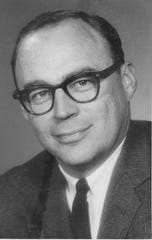April 17, 2020
Downtown Detroit’s famous NBD Building architect dies at 91
This article is written by Andrea Perez Balderrama of the Detroit Free Press. You can view the original article here.
John Calvin Haro, the architect and designer of the National Bank of Detroit headquarters, the historic building downtown Detroit where Quicken Loans is now located, died on April 9 in Phoenix, Arizona, at age 91.

John Calvin Haro (Photo: Albert Kahn Associates, Inc.)
A longtime member of the Albert Kahn Associates architectural firm, Haro gained prominence for designing dozens of important buildings — from landmark headquarters for a number of corporations to many buildings on the University of Michigan campus in Ann Arbor.
Haro’s many projects at U-M include the Physics and Astronomy Building, the Modern Languages Building, the Adult General Hospital, the Graduate Library addition, and the the Duderstadt Center, Information Technology Center and Library.
Born in Gary, Indiana, in 1929, the notable architect grew up in Michigan and completed his undergraduate studies at Michigan Technical University and the University of Michigan. From the latter, he obtained a bachelor’s degree in architecture in 1950.
Haro served in the U.S. Navy during the Korean War, after which he went to earn a Master of Architecture at the Harvard University Graduate School of Design in 1955.
During his time at Kahn, he held many positions, including senior vice president and director of design and planning.

Washington Post Old Downtown Washington, D.C. Headquaters. (Photo: Albert Kahn Associates, Inc.)
He was a recipient of Harvard University’s Wheelwright Traveling Fellowship and a Fellow with the American Institute of Architects. Haro received many awards for design and urban planning, including the Gold Medal from the Detroit Chapter of the AIA and Michigan Society of Architects.
“John was a valued and willing mentor for many architects around the country, and in his own firm. He led an incredible list of Kahn projects for a diverse collection of appreciative clients,” said Alan H. Cobb, president and CEO of the Kahn firm.

The University of Michigan’s Duderstadt Center (Photo: Albert Kahn Associates, Inc.)
Haro also oversaw the creation of the Avon corporate headquarters, Eli Lilly’s Engineering Technology Center, and the Washington Post headquarters.
After his retirement, Haro designed private homes, churches and additions to schools in the Houghton and Hancock area of Michigan.
He was a longtime resident of Birmingham and Houghton, and Scottsdale, Arizona, where he continued his work as architect and developed his passion for drawing, painting and connecting with his Finnish heritage.
Haro was preceded in death by his wife of 65 years, Elizabeth. He is survived by his children; John S., Alex, and Alison; and five grandchildren.
